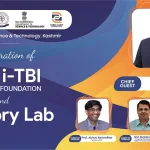New Delhi, Aug 23: “Hail India on Moon! Hail ISRO!” was the opening sentence of Union Minister of State (Independent Charge) Science & Technology; MoS PMO, Personnel, Public grievances, Pensions, Atomic Energy and Space, Dr Jitendra Singh, who is also MoS Incharge Space, soon after the successful soft landing of Chandrayaan 3 on the surface of Moon in the South Pole area, on Wednesday evening.
Simultaneously, in a tweet that exactly coincided with the precise moment of the landing of Chandrayaan-3, Dr Jitendra Singh said, “While others fantasize Moon, we have felt the Moon. While others stuck in flight of dreams, #Chandrayaan3 has actualised the dream.Tricolour flies high in lunar skies affirming India’s resolve,as articulated by PM @narendramodi,“Sky is not the limit”.
In a brief statement to the media, Dr Jitendra complimented ISRO Chairman, S. Somanath, Mission Director, Mohan Kumar and the entire Team ISRO for having placed India’s national pride on the Moon in the virgin terrain of the South Polar area, not accessed by any other space mission so far. “It is difficult for common citizens to understand how much consistent labour, hard work, commitment and passion have been put in while working day and night for months and years together to ensure meticulous planning and the minutest details for the success of the mission,” he said.
After this successful feat, the union minister said India has reaffirmed its position as the world’s frontline leading nation in the space sector. He gave full credit to Prime Minister Narendra Modi for enabling India’s space scientists to vindicate the dream of their founding father Vikram Sarabhai by “unlocking” India’s Space sector and providing a milieu in which India’s huge potential and talent could find an outlet and prove itself to the rest of the world.
Dr Jitendra Singh further informed that the Vikram has landed in a hazard-free location with the help of its algorithm and instruments and the tilt to the Lander is very small as measured by the inclinometers onboard. While the cameras onboard the Vikram have beamed the pictures of the moon and confirmed the touchdown, the confirmation is available from other sensors as well, he added.
Narrating the further sequence of activities from this moment onwards, Dr Singh said the experiments onboard Vikram and Pragyan will be happening on all days and as much data will be collected from all instruments until the Moon’s Day lasts for the next 14 days.
“At the end of the next 14 days followed by night and extreme cold conditions when the day breaks again, solar power generation for Vikram and Pragayaan is expected to start again. The orbiter is designed to withstand long periods of life,” he said.





